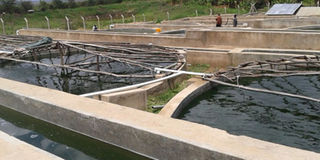Farm where female fish are turned into males

A section of the tanks at the Kamuthanga Fish farm in Mua Hills, Machakos. PHOTO | STEPHEN MUTHINI | NATION MEDIA GROUP
What you need to know:
- Thousands of fish fingerlings can be seen swimming in the water buckets. These, we learn, are tilapia juvenile fishes.
- According to Alex Akidiva, a scientist at Egerton University, sex reversal in fish is legal, but only for government-certified farming groups.
- At the hatching stage, fingerlings are born with a 50-50 hormonal balance, meaning they are neither male nor female.
A system of elaborate water pipes, cemented tanks and tunnels joining the tanks to form what looks like miniature swimming pools is what you see when you enter this premises in Mua Hills, Machakos County.
At an adjacent chamber, more water pipes, buckets, and electricity switches dot the cool room whose temperatures are regulated.
Thousands of fish fingerlings can be seen swimming in the water buckets. These, we learn, are tilapia juvenile fishes.
Welcome to Kamuthanga Fish Farm, where female fish fingerlings undergo sex reversal to become male.
The fish hatchery has an estimated 800,000 to 1 million fingerlings.
Joseph Odhiambo, the attendant at the hatchery, explains that at the age of eight days, fingerlings’ sex is still not fully developed.
A hormone known as 17 Beta Methyl Testosterone that changes the hormones of fish fingerlings is introduced into the water to convert female fish into male, Odhiambo says. “We prefer males because males grow two times faster than females. It’s more economical to rear males because they take a shorter period to achieve maximum weight.”
The hatchery has four chambers with an estimated 250,000 fingerlings in each chamber.
Fish eggs from the farm are put in circulation tubes in the first chamber. Odhiambo says they trap the fertilised eggs from the mouth of female fish before they hatch.
The egg-producing fish are reared normally in the farm.
Hatching takes 10 days at the chamber because there are heaters to regulate temperatures for maximum effect. This takes place in chamber one.
From there, the fingerlings are collected into bowls using sieves and put into chamber two. Here, formulated fish feeds with 57 per cent proteins are introduced alongside the hormone-changing chemicals.
BEING TRANSFERRED
The fingerlings stay in the system for two for seven days before being transferred into chamber three.
“Sex reversal, which began in chamber two, ends in chamber three. Those who were male are now converted to female,” says Odhiambo. This stage takes a maximum of 28 days.
Chamber four is the holding tank where the fish grow before being transferred to the outgrowing unit outside the system.
The water used at the hatching chambers is recycled and finally disposed of at a wasteland in the farm.
A borehole on the farm provides water throughout the year.
Jason Hammona, the aquaculture manager at the Kamuthanga Farm, says through sex reversal, they are able to get 95 per cent of male fish from the pool.
OUTGROWING PLANT
Hammona says sex reversal and speeded-up hatching of fingerlings is necessary to meet increased demand for fish.
“We need to double the supply. This type is called highland-based aquaculture system. I’m only using 10 per cent of our water so in terms of water conservation it’s very good,” Hammona says.
This reversal business, though, is not a matter for the faint-hearted. There are 22 tanks and 28 septic tanks each holding 50,000 litres of water in the outgrowing plant.
Anthony Ndeto, the owner of Kamuthanga Farm, says has spent an estimated Sh7 million on the fish farm. The borehole that supplies water to the system cost Sh2 million to sink.
Hammona advises farmers to ensure a steady supply of water before venturing into this business.
He intends to sell both the fish and the fingerlings from the farm in local markets.
Apart from fish farming, the larger part of the farm is occupied by horticultural crops including, tomatoes, cabbages, sweet potatoes, lettuce, eggplant, and even peanuts.
The horticulture section has thrived with the support from USAid, Kenya Horticulture Competitive Project (KHCP) and Syngenta.
Ndeto says his background in marketing has helped in the farming venture as his products usually have a ready market.
“Farming may not be the most difficult thing, marketing is. Here we start with the marketing first and get orders for our products,” Ndeto says.
According to Alex Akidiva, a scientist at Egerton University, sex reversal in fish is legal, but only for government-certified farming groups.
At the hatching stage, fingerlings are born with a 50-50 hormonal balance, meaning they are neither male nor female.
However, certified farmers can ensure they all turn out to be males by introducing the 17 Beta Methyl Testosterone hormone before the fingerlings are seven days old.
“You start by introducing two grammes of the hormone and reduce the amount gradually as the fingerlings weigh more,” the scientist says.
At maturity (six months), males weigh half a kilogramme and above while female fish weigh about 400 grammes.
This means that people keeping fish for commercial reasons are better off dealing with more males than females.
According to Akidiva, females weigh less because they spend a lot of energy on reproduction, which starts at the age of three months.
BROOD IN THE MOUTH
“Female fish brood in the mouth meaning they do not eat for at least four days,” says Akidiva.
“They also guard young ones against prey by putting them in the mouth.” The hormone has no side effects on consumers, according to Akidiva, but he emphasises that it has to be administered by certified experts only.
Already, he says, the fish naturally have the hormone at hatching. Only an addition to what was already there is done. The hormone does not affect the nutritional value or taste of the fish, he says.
Additional reporting by Rachel Kibui





